Mercury at Maximum near Mars, the Young Moon meets Pretty Planets, and Touring the Lucky Stars of Aquarius!

Globular star Cluster Messier 2 aka NGC 7089 is located 55,000 light-years from our sun in the constellation of Aquarius. In binoculars and backyard telescopes, the cluster will appear as a faint fuzzy patch of light – as opposed to this spectacular Hubble space Telescope image from earlier this year. NASA APOD for April 4, 2019.
Here are your Astronomy Skylights for the week of November 24th, 2019 by Chris Vaughan. Feel free to pass this along to your friends and send me your comments, questions, and suggested topics. I repost these emails with photos at http://astrogeo.ca/skylights/ where all the old editions will be archived. You can also follow me on Twitter as @astrogeoguy! Unless otherwise noted, all times are Eastern Time. To subscribe to these emails please click this MailChimp link.
I can bring my Digital Starlab portable inflatable planetarium to your school or other daytime or evening event. Contact me through AstroGeo.ca, and we’ll tour the Universe together!
The mainly moonless skies this week will permit exploring the modest water constellations of the zodiac. The worldwide evening sky this week will deliver a spectacular meet-up of the moon with the brightest planets Venus, Jupiter, and Saturn. Elusive Mercury and reddish Mars will be nicely visible in the east before the morning sun. Here are your Skylights!
Meteor Showers This Week
The annual Leonids Meteor shower, derived from material left by repeated passages of periodic Comet 55P/Tempel-Tuttle, will be tapering off this week. It peaked before dawn on Sunday, November 17, but you can expect to see some leftover Leonids, many with persistent trains, now that the moon has waned in phase and brightness.
The Moon and Planets
Early risers on Monday morning can look for the old crescent moon sitting prettily to the lower left (or celestial east) of bright Mercury in the east-southeastern pre-dawn sky. On Tuesday morning, the moon will disappear during its monthly meeting with the sun, and then reappear as a fresh, young crescent in the western sky after sunset on Wednesday.
From Wednesday through Friday, the moon will wax fuller while it flees the sun, and pay a visit to three bright planets. On Wednesday, the moon will be positioned about a fist diameter to the lower right (celestial west) of Venus and Jupiter. On Thursday, the moon’s orbital motion will bring it a small distance to Venus’ upper right. An on Friday evening, the moon will sit a few degrees to the lower left (or celestial south) of Saturn. All of these encounters will make a pretty sight in binoculars, and a lovely widefield photograph. Try propping up your smartphone on something sturdy outside, and using the shutter delay to take a photo! But don’t dawdle – the objects will set in the west between 5 and 6 pm local time.

On the coming weekend, the waxing crescent moon will traverse the stars of Capricornus (the Sea-Goat).
Mercury and Mars are putting on a show in the eastern pre-dawn sky. Red-tinted Mars will rise first – at about 5 am local time. From now until October, 2020, Mars will continuously grow in brightness in the sky – and in apparent size when viewed in telescopes. In fact, the 2020 Mars opposition will be a terrific excuse to get a telescope for the 2019 Holidays so you can practice viewing the planet during the spring and summer months of 2020! I’ll share some telescope recommendations in the next week or two.
Mercury is very nicely positioned for viewing now. It’s low in the east-southeastern pre-dawn sky all week. It will climb higher and be easier to spot every morning until Thursday – when it will reach its greatest angle away from the sun. Then it will begin to descend into the morning twilight again. The best viewing time for Mercury will be before 6:45 am local time. This latest morning apparition for Mercury is the best one for Northern Hemisphere observers in 2019, but a poor one for those viewing it from mid-southern latitudes. Watch for the old crescent moon about a palm’s width below Mercury on Monday morning.
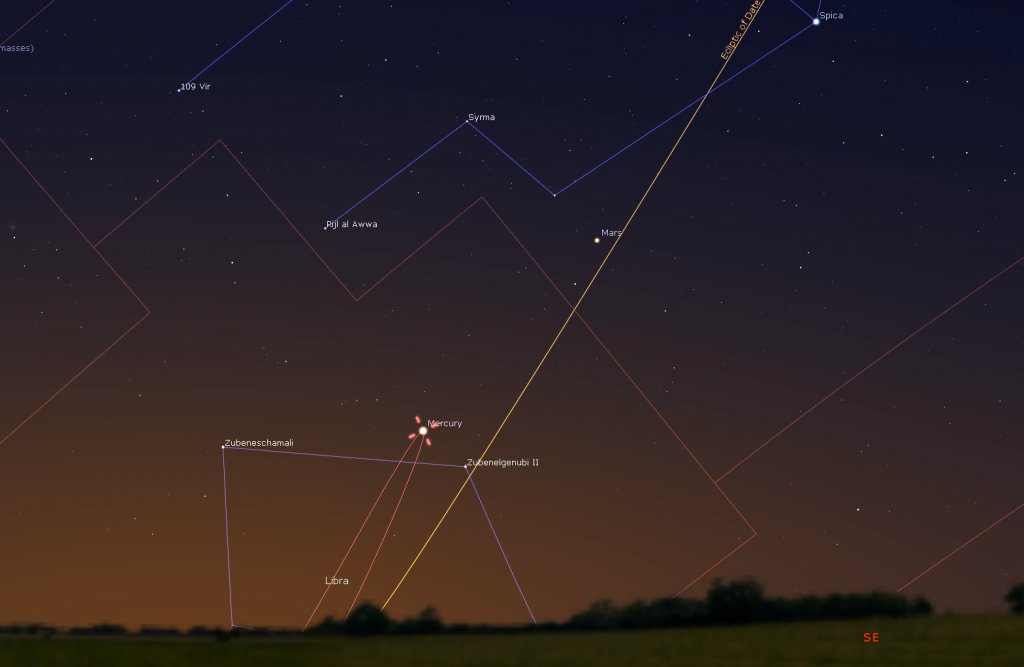
The three brightest planets Venus, Jupiter, and Saturn are all in the southwestern sky after sunset this week.
Now shining at a spectacularly bright magnitude of -3.85, Venus is still being held low in the southwestern post-sunset sky by the shallow angle of the evening ecliptic. The planet is gradually ascending out of the surrounding evening twilight, and will be fairly easy to spot for a while after sunset this week, if you can find an open horizon to the southwest. The planet will set at about 6:15 pm local time.
Jupiter and Venus are moving in opposite directions – which has caused them to meet up spectacularly now. Venus’ orbital motion is carrying it eastward away from the sun, while Jupiter (along with the stars around it) is being carried westward toward the sun by the Earth’s orbital motion.
Tonight (Sunday) Jupiter will be positioned only two finger widths to the right (or the celestial northwest) of Venus, which is six times brighter than Jupiter. Over the course of this week, you can watch planetary motions in action as Venus slides up to Jupiter’s left while Jupiter sinks to the right – and sets soon after 6 pm local time.
Yellow-tinted Saturn, which is much less bright than Jupiter due to its smaller diameter and larger distance from us, is still a reasonably good option for viewing in backyard telescopes. Saturn is positioned about 1.5 fist diameters to the upper left (or celestial east) of Venus. Start looking for the ringed planet in the lower part of the south-southwestern evening sky after dusk, when Saturn will be located about 1.5 fist diameters above the horizon. It will set in the west-southwest at 7:15 pm local time. Venus will shake hands with Saturn on December 10-11.
For your late-evening viewing pleasure, I offer you the ice giant planets Uranus and Neptune!
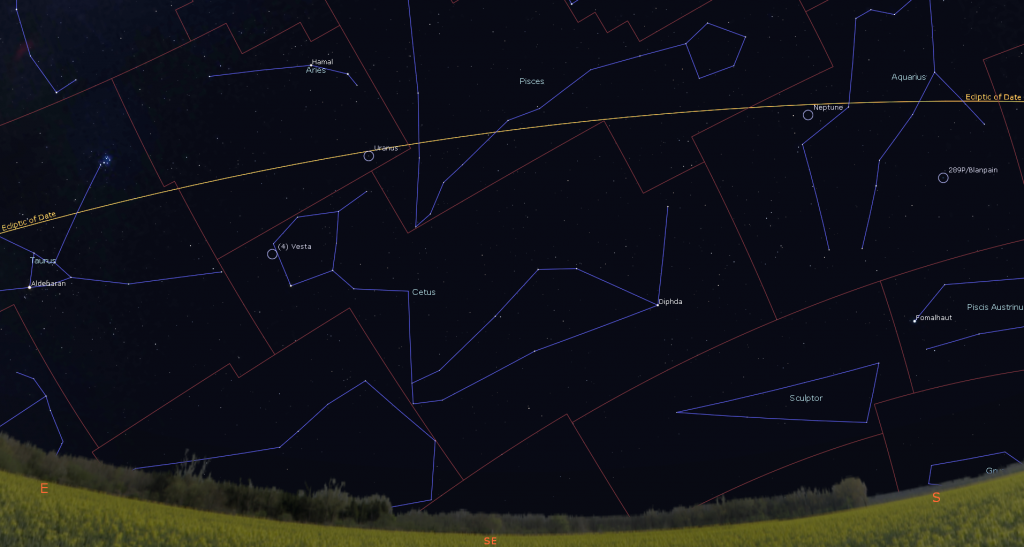
Distant and dim, blue Neptune is visible from full evening darkness until almost midnight local time. It is sitting among the stars of eastern Aquarius (the Water-Bearer), and is positioned less than a finger’s width to the right (or celestial west) of a medium-bright star named Phi (φ) Aquarii. Both blue Neptune and that golden-coloured star will appear together in the field of view of a backyard telescope at low power. With the bright moon out of the night sky, magnitude 7.9 Neptune is actually visible in binoculars, too. Find Phi Aquarii first and then locate nearby Neptune.
The distance between the star and the planet has been steadily increasing due to Neptune’s westward retrograde orbital motion. But on Wednesday, Neptune will complete a retrograde loop that has been carrying it westward since mid-June. After that date, Neptune will resume its regular prograde eastward motion through the stars and will slowly swing back towards Phi Aquarii. I’ll post a diagram of Neptune’s position compared to that star here. By the way, retrograde loops of planets are caused when the Earth passes them on the “inside track” of the solar system.
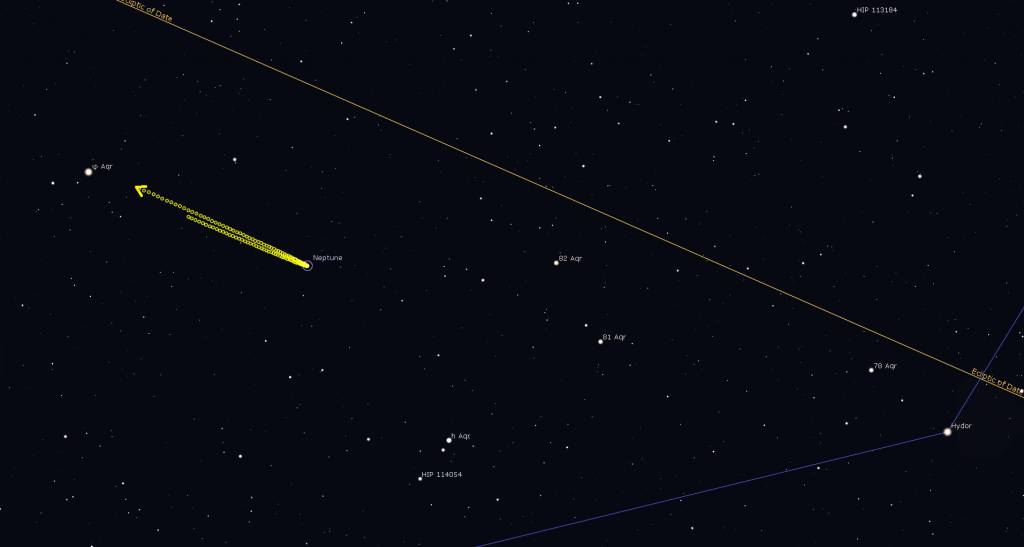
Blue-green Uranus is only a few weeks past its minimum distance from Earth for this year, so it is still near peak visibility for 2019. This fall, Uranus is sitting a large palm’s width to the left (or to the celestial east) of the “V” of Pisces (the Fishes), below (or to the celestial south of) the stars of Aries (the Ram), and is just a palm’s width above the ring of stars that form the head of Cetus (the Whale).
Shining at a peak brightness of magnitude 5.7, Uranus is also bright enough to see in binoculars and small telescopes under dark skies. You can use the three modest stars that form the top of the head of the whale (or sea-monster in some tales) to locate Uranus for the next several months – because the distant planet moves so slowly in its orbit. To help you find it, I posted a detailed star chart here. If you can wait until about 10 pm local time to view it, when it is higher in the sky, you’ll be looking through the least amount of Earth’s disturbing atmosphere.
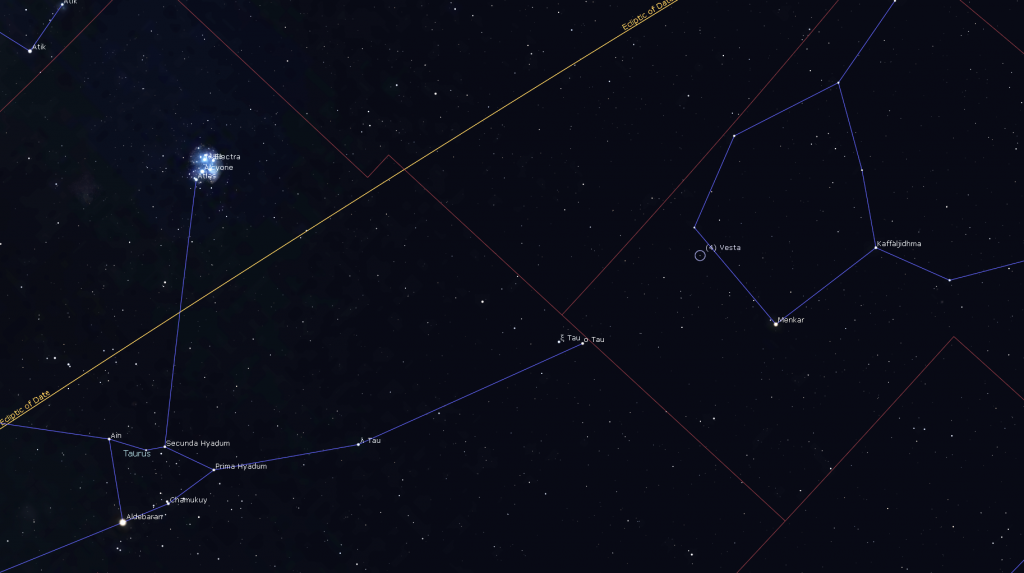
On November 12, Earth’s orbit carried us between the minor planet (and asteroid) Vesta and the sun – allowing Vesta to be visible all night long, and to appear at its brightest (magnitude 6.5) for the year – well within reach of binoculars and small telescopes. Look for Vesta in eastern Cetus (the Whale). The asteroid is four finger widths to the upper left (or to the celestial north) of the medium-bright star Menkar – in the direction of the Pleiades star cluster.
I’ll post sky charts for Vesta and all the observable planets here.
The Water Constellations – The Lucky Stars of Aquarius
Late autumn evenings feature an interesting grouping of constellations over the southern horizon – the water constellations. They aren’t very prominent, consisting mainly of dim stars, but this week’s nearly moonless sky will offer an opportunity to see them more easily. Despite their modest appearance, you will have heard of these constellations because they straddle the ecliptic, and are therefore zodiac constellations.
A month ago, I toured you through Capricornus (the Sea-Goat), the second dimmest constellation of the heavens, and the most westerly of the set. It’s still visible in early evening, and that tour can be read here. This week, we’ll focus on the sea-goat’s eastern neighbour Aquarius (the Water-Bearer).

Aquarius is one of the oldest recorded constellations, probably because of its place on the ecliptic / zodiac and because it re-appeared in the morning sky at the time of year that brought the return of desperately needed rains and the flooding of the Nile in ancient Egypt. It certainly was not because of its stars. The constellation is composed of about 14 modestly-bright stars with visual magnitudes that are near the limit for suburban observers.
Aquarius spans an area that measures about 3.5 outstretched fist diameters wide by 2 diameters high (or 35 by 20 degrees). It is traditionally depicted as a kneeling figure, facing east, who is pouring water from a vessel. A crooked horizontal string of stars represent his right arm outstretched towards the west, then his bowed head and shoulders, and finally his left hand, which bears the jug. This is the most easily seen part of the constellation. Descending from that line is a loose chain of stars representing the flowing water and another representing his torso and legs. In some stories, he’s Zeus pouring out the water of life upon the world. In others, the waters are those of the biblical flood, a story handed down from the Sumerians. As we’ll soon see, the stars of Aquarius are “lucky”.
By the time the sky has darkened enough to see it, Aquarius has already completed half of its nightly trip across the sky, and is sitting due south. For mid-northern latitude observers, it is positioned midway between the southern horizon and the zenith. Since it also touches the celestial equator, it will be nearly overhead for observers viewing it from near the Earth’s equator. That celestial real estate also means that Aquarius is visible from everywhere on Earth except the northern polar region.
To help you find Aquarius, use the great square (or baseball diamond) of Pegasus, which sits much higher in the sky and to Aquarius’ left (i.e., to the celestial northeast). With Pegasus’ “home plate” as the bottom star, extend an imaginary line from third base to first base, and continue in the same direction by the same distance (about two fist diameters) to Aquarius’ highest and brightest star, Sadelmelik.
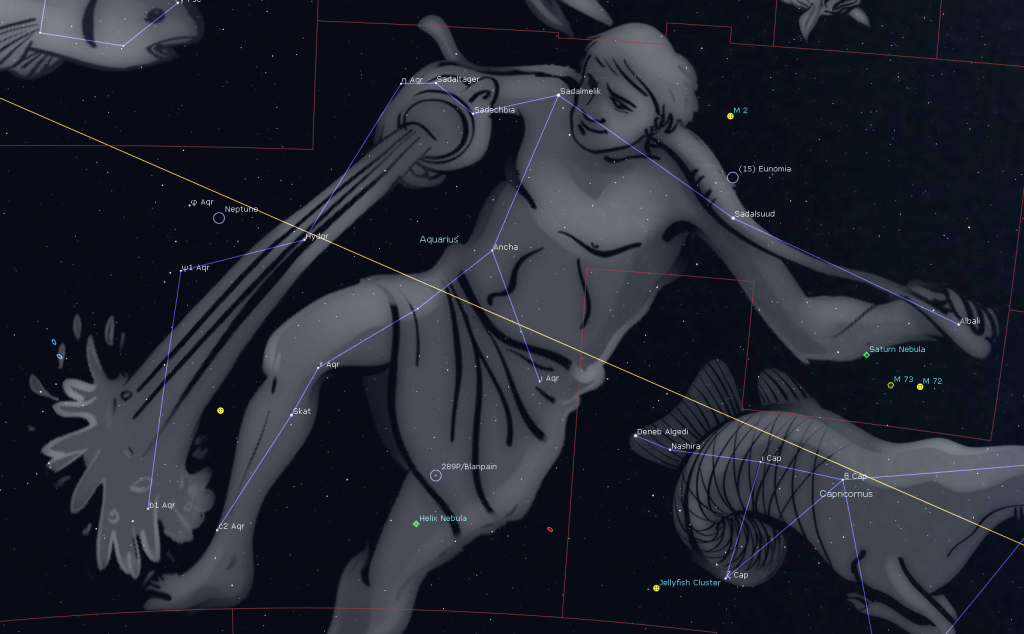
In a dark sky, up to 100 stars can be counted within Aquarius, but only a few are easily seen near city lights. Try to spot the four stars that extend a wide palm’s width from Sadelmalik eastward to the left. One of the four stars is a bit lower than the other three. At the eastern end of the foursome sits a modest star designated Eta Aquarii. The radiant of the springtime Eta Aquariid Meteor Shower is located close to that star.
Jumping 1.5 finger widths to the right of Eta brings us to a closely spaced double star that’s only 91 light-years away from us named Sadaltager “Luck of the merchant”. Two finger widths to the lower right of Sadaltager is the white star Sadachbia, which comes from the Arabic phrase sa’d al-akhbiya “Lucky stars of the tents”. Then we hop higher again and westward to Sadelmelik, meaning “Lucky stars of the Kingdom”. Sadelmelik is a very mature, yellow supergiant star located about 520 light-years away from us. It’s a bit cooler than our Sun, but about 60 times larger in diameter, making it much more luminous.
Ten degrees (a fist’s diameter) to the lower right of Sadalmelik, at the water-bearer’s elbow, sits another of the constellation’s brighter stars, Sadalsuud “The luckiest of all of them all”. This is another yellow giant very similar to Sadelmelik and about as distant. Finally, Aquarius’ western hand is marked by a fainter, blue-white star named Albali “Good Fortune of the Swallower”, which sits a fist’s width to the lower right of Sadalsuud. The rest of the constellation, descending in two crooked lines from the lucky stars, is fairly dim. About halfway along them, both lines take a jog to the left (east).
Aquarius contains only a few significant deep sky objects because it is situated away from the Milky Way, our galaxy’s central plane. The bright globular star cluster designated Messier 2, which can be spotted in binoculars or small telescopes, is only 4 finger widths above Sadalsuud. It’s 37,000 light-years away! A planetary nebula named the Saturn Nebula (and also designated Caldwell 55) is located below Albali. At 650 light-years away, it’s among the closest such objects to us. Another planetary nebula, the Helix Nebula (or Caldwell 63), is located near the bottom, southerly border of the constellation. These two stellar corpses are visible in backyard telescopes. A second, dimmer globular cluster named Messier 72 sits below and between Albali and the Saturn Nebula.
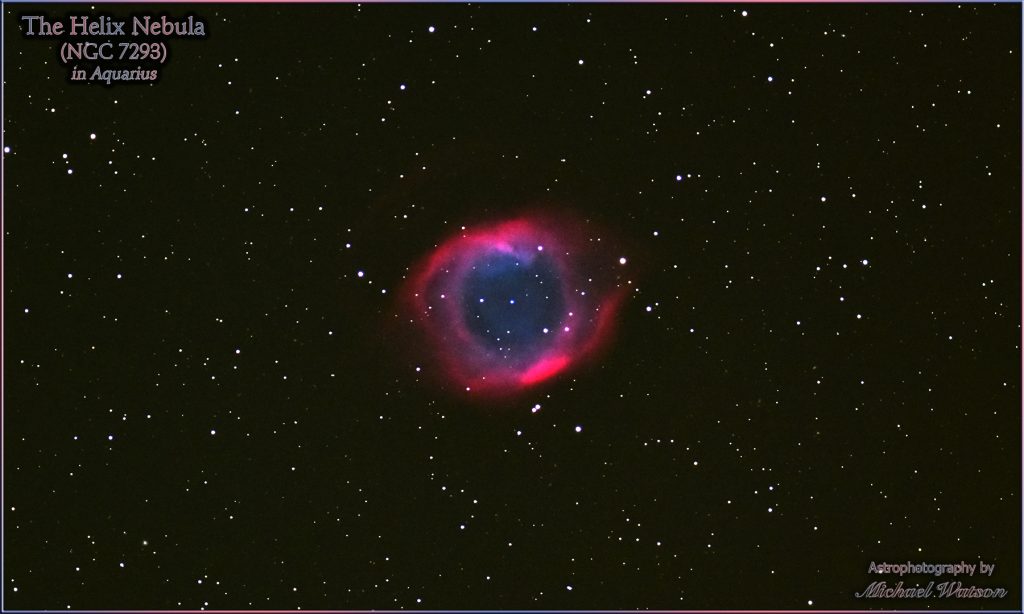
Fittingly, the god of the seas Neptune has been situated in Aquarius since 2011. At present, Neptune is to the left (east) of a fairly bright star named Hydor, and to the right of a dimmer star named Phi (φ) Aquarii. Neptune won’t swim out of Aquarius until about 2022! I’ll post a sky chart for Aquarius and some photos of its splendors here.
Public Astro-Themed Events
Taking advantage of dark, moonless evening skies this week, astronomers with the RASC Toronto Centre will gather for dark sky stargazing at Long Sault Conservation Area, northeast of Oshawa on (only) the first clear evening (Monday, Tuesday, or Thursday) this week. You don’t need to be a RASC member, or own any equipment, to join them. Check here for details and watch the banner on their homepage or their Facebook page for the GO or NO-GO decision around 5 pm each day.
Every Monday evening, York University’s Allan I. Carswell Observatory runs an online star party – broadcasting views from four telescopes/cameras, answering viewer questions, and taking requests! Details are here. On Wednesday nights they offer free public viewing through their rooftop telescopes, including their brand new 1-metre telescope! If it’s cloudy, the astronomers give tours and presentations. Registration and details are here.
At 7:30 pm on Wednesday, November 27, the RASC Toronto Centre will hold their free monthly Speaker’s Night Meeting at the Ontario Science Centre, and the public are welcome. This month, the speaker will be the terrific speaker Dr. Renée Hložek, Assistant Professor at the Dunlap Institute for Astronomy & Astrophysics and the Department of Astronomy & Astrophysics at U of T. Her topic will be Illuminating the Dark Universe with Things that Go Bang in the Night. Check here for details. Parking is free.
On Wednesday, November 27 from 7 to 9 pm, U of T’s Astronomy & Space Exploration Society (ASX) will present a free public panel discussion entitled Methods of Modern Astronomy, which will review the ways astronomers are carrying out cutting-edge astronomy. Details are here.
This Fall and Winter, spend a Sunday afternoon in the other dome at the David Dunlap Observatory! On Sunday afternoon, December 8, from noon to 4 pm, join me in my Starlab Digital Planetarium for an interactive journey through the Universe at DDO. We’ll tour the night sky and see close-up views of galaxies, nebulas, and star clusters, view our Solar System’s planets and alien exo-planets, land on the moon, Mars – and the Sun, travel home to Earth from the edge of the Universe, hear indigenous starlore, and watch immersive fulldome movies! Ask me your burning questions, and see the answers in a planetarium setting – or sit back and soak it all in. Sessions run continuously between noon and 4 pm. Ticket-holders may arrive any time during the program. The program is suitable for ages 3 and older, and the Starlab planetarium is wheelchair accessible. For tickets, please use this link.
Keep looking up, and enjoy the sky when you do. I love questions and requests – so, send me some!